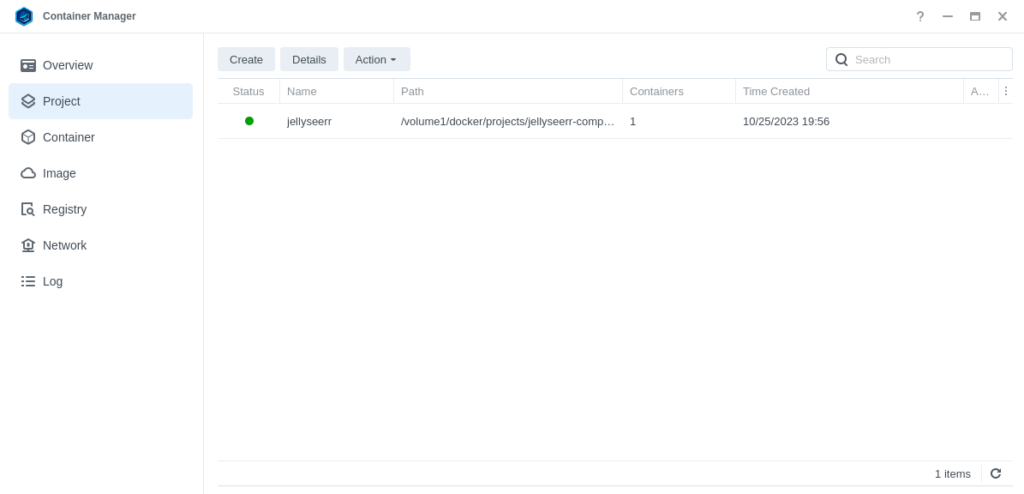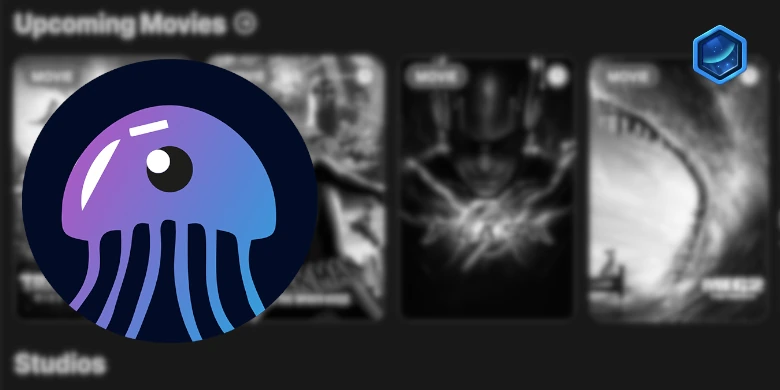Last updated on 6 October 2025
Important or Recent Updates
| Historic Updates | Date |
|---|---|
| Guide updated for Container Manager | 21/05/2023 |
| Moved from UI setup to Project Setup which is more flexible and easier to maintain. Added an addition element to the compose to restrict the container from gaining additional privileges. | 25/10/2023 |
| Added specific DNS servers to use – This is not required but useful if you are having speed issues! | 23/06/2024 |
06/10/2025 – Great News – Jellyseerr and Overseerr development is merging and due to this I will shortly merge this and the Overseerr guide 🙂
For the moment use the image in this guide, but I will swap both over to the newly merged image after the Beta is over.
What is Jellyseerr
Jellyseerr (a fork of Overseerr) is a web front end for the users of your Jellyfin, Emby or Plex Server, it allows them to request new Movies and Shows which are then passed to Radarr and Sonarr for automated download.
Let’s Begin
In this guide I am going to take you through the steps to get Jellyseerr up and running in Docker on your Synology NAS.
In order for you to successfully use this guide please follow the two steps below first.
This guide contains two parts:
- Part 1 — Setting up the container in Container Manager
- Part 2 — Setting up DDNS, Reverse Proxy and SSL
Part 1 — Container Set up
Folder Setup
Let’s start by getting some folders set up for the containers to use. Open up File Station create the following.
/docker/projects/jellyseerr-compose
/docker/jellyseerr
Container Manager
Next we are going to set up a ‘Project’ in Container Manager. Open up Container Manager and click on Project then on the right-hand side click ‘Create’.

In the next screen we will set up our General Settings, enter the following:
| Section | Setting |
|---|---|
| Project Name: | jellyseerr |
| Path: | /docker/projects/jellyseerr-compose |
| Source: | Create docker-compose.yml |
Next we are going to drop in our docker compose configuration copy all the code in the box below and paste it into line ‘1’ just like the screenshot.
What on earth is a Docker Compose? Docker Compose allows us to define how Docker should set up one or more containers within a single configuration file. This file is yaml formatted and Container Manager uses the Projects feature to manage them.

services:
jellyseerr:
image: fallenbagel/jellyseerr:latest
container_name: jellyseerr
user: UID:GID #YOUR_UID_AND_GID
environment:
- TZ=Europe/London #CHANGE_TO_YOUR_TZ
volumes:
- /volume1/docker/jellyseerr:/app/config
ports:
- 5055:5055/tcp
network_mode: synobridge
dns: #DNS Servers to help with speed issues some have
- 9.9.9.9
- 1.1.1.1
security_opt:
- no-new-privileges:true
restart: alwaysEnvironment Variables
We need to make some changes in order for the container to have the correct permissions to save its configuration files and to have access to your media.
| Variable | Value |
|---|---|
| user: | (required) The UID and GID you obtained in the user setup guide should be entered here |
| TZ | (required) Your timezone wikipedia.org/wiki/List_of_tz_database_time_zones |
Click ‘Next’
You do not need to enable anything on the ‘Web portal settings’ screen click ‘Next’ again.

On the final screen click ‘Done’ which will begin the download of the container image and once downloaded it will be launched!

The image will now be downloaded and extracted. You should see ‘Code 0’ when it has finished.

The Project should now be running with a Green status

Firewall Exceptions
(Skip if you don’t have the Firewall configured)
If you have the Synology Firewall enabled please see this additional guide for further info on exceptions and correct set up.
Container set up completed
You should now be able to access the web interface via the IP of your NAS followed by the port 5055
e.g. 192.168.0.30:5055

As Jellyseerr has a really nice initial setup UI that takes you through the basics I won’t be covering this.
You are ready to roll 🙂
Important Note:
If you’re utilizing Jellyfin along with Jellyseerr and wish to grant certain users the ability to request shows or movies, it’s recommended not to import these users. Instead, let them complete their initial login independently. This approach avoids an issue where users might be mistakenly associated with your requests due to a bug.
External Access
You have some choices when it comes to making your new container accessible from outside your home network, these come with different levels of security and convenience. This mini section is generic but covers the basics of getting this guide up and running and is entirely optional.
- Synology’s DDNS (Dynamic Domain Name System) with a TLS Certificate and Reverse Proxy
This is useful if you have some family members or friends that need access to something like Overseerr or Jellyseer and is covered below. - Tailscale or Wireguard VPN
If just you or close family in your household are accessing these services, and you don’t want to expose them to the internet this would be the more secure choice. See my other separate guides. - Cloudflare Tunnels
I don’t currently use these, so I would recommend watching the Wundertech guide on how they work.
A note on Double NAT or CGNAT
Unfortunately more ISPs are moving to these methods of address allocation as the IPv4 address space is getting low on available addresses. If your ISP is doing this your choices are more limited.
You can test if this is the case by checking the WAN IP on your Router/Modem settings and then comparing it to the one shown on portchecker.co. If they are different you are likely Double NAT and will either need to see if you can pay your ISP for a standard IPv4 address or use Tailscale or Cloudflare Tunnels for access.
Using the built-in tools on DSM
The first step of this process is to forward port 443 on your Router to your NAS IP Address, how you do this will depend on your router model, so please refer to its manual.
Router (External):443 > NASIP (Internal):443
Next make sure you have registered for a Synology Account as we are going to be using their DDNS service. https://account.synology.com/en-uk/register/ If you already have this set up move to the next step.
DDNS (Dynamic Domain Name System)
A DDNS address allows you to get external access to your container via an address provided by Synology, this is useful on home internet connections where your ISP will change your IP address on a semi-regular basis.
In the DSM Control panel go to ‘External Access’ and then to the ‘DDNS’ tab

Click on ‘Add’, then fill out the following sections.
| Section | Value |
|---|---|
| Service Provider | Synology |
| Hostname | This will be the unique address just for you so keep the name generic. minecraft.synology.me = BAD myawesomenas.synology,me =GOOD |
| Email: | Log into your Synology account |
| External Address (IPv4) | This should be filled in automatically |
| External Address (IPv6) | This should be filled in automatically if your ISP is using IPv6 |
| Get a Cert from Let’s Encrypt | Tick this box |
| Enable Heartbeat | Tick this box |
Now press OK, DSM will apply your settings. It can take a few moments to set up and the DSM interface will refresh. You will likely receive a certificate error which you will need to accept to get back into DSM.
Reverse Proxy
We are going to set up a reverse proxy subdomain for the address you just register. This means you and your users can access the container without using a port number as it will route all traffic through the secure 443 port.
Go back into the Control Panel and access the ‘Login Portal’ then in the ‘Advanced’ tab click ‘Reverse Proxy’ and then click on ‘Create’.

We are now going to enter some rules, so when you or your users access the URL specified the request will automatically be sent to the containers web UI.
Use the settings below, you will need to amend the Hostname sections in line with the hostname you registered earlier, and the IP of your NAS.
| Setting | Value |
|---|---|
| Reverse Proxy Name: | Give it a meaningful name in line with the container you are setting up. |
| Protocol: | HTTPS |
| Hostname: | containername.xxx.synology.me ‘containername‘ will be the name you want to use to access this container ‘.xxx.synology.me‘ will be the exact name you registered earlier |
| Port: | 443 |
| Protocol: | HTTP |
| Hostname: | ‘localhost’ or your NAS IP address |
| Port: | The UI Port Number from the yaml in the guide you are following |
On the second tab ‘Custom Header’ click on Create then WebSocket, this will add two entries for WebSockets to function correctly, you can now press save.

You should now be able to access the web UI of the container by going to the address you just set up in the reverse proxy, it will be a secure connection, and you should have no certificate errors.
Looking for some help, join our Discord community
If you are struggling with any steps in the guides or looking to branch out into other containers join our Discord community!

Buy me a beverage!
If you have found my site useful please consider pinging me a tip as it helps cover the cost of running things or just lets me stay hydrated. Plus 10% goes to the devs of the apps I do guides for every year.


